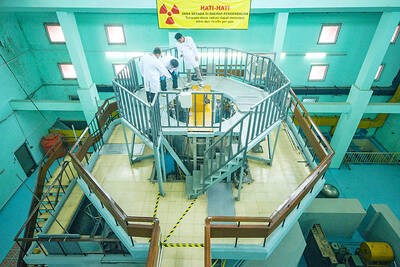Europe's first spacecraft to the moon ended its three-year mission yesterday with a planned crash on the lunar surface, hitting its target at 2kps, or 7,200kph.
The impact, in a volcanic plain called the Lake of Excellence, was captured by observers on earth, and scientists hoped the resulting cloud of dust and debris would provide clues to the geologic composition of the site.
"That's it -- we are in the Lake of Excellence," said spacecraft operations chief Octavio Camino as applause broke out in the European Space Agency's mission control center in Darmstadt, Germany. "We have landed."
Minutes later, a video screen on the control room wall showed an image of the bright flash from the impact. The infrared image was captured by the Canada France Hawaii Telescope on Mount Kea in Hawaii.
"It was a great mission and a great success and now it's over," mission manager Gerhard Schwehm said.
During its months in orbit around the moon, the spacecraft scanned the lunar surface from orbit and took high-resolution pictures. But its primary mission was testing a new, efficient, ion propulsion system officials hope to use on future interplanetary missions including the BepiColombo mission to Mercury slated for 2013.
Launched into Earth's orbit by an Ariane-5 booster rocket from Kourou, French Guiana, in September 2003, Smart-1 used its ion engine to slowly raise its orbit over 14 months until the moon's gravity grabbed it.
The engine, which uses electricity from the craft's solar panels to produce a stream of charged particles called ions, generates only small amounts of thrust but only needed 80kg of xenon fuel.
The craft's X-ray and infrared spectrometers have gathered information about the moon's geology that scientists hope will advance their knowledge about how the moon's surface evolved and test theories about how the moon came into being.
On Saturday, mission controllers had to raise the craft's orbit by 600m to avoid hitting a crater rim on final approach. Had the orbit not been raised, the craft would have crashed one orbit too soon, making the impact difficult or impossible to observe.

Four people jailed in the landmark Hong Kong national security trial of "47 democrats" accused of conspiracy to commit subversion were freed today after more than four years behind bars, the second group to be released in a month. Among those freed was long-time political and LGBTQ activist Jimmy Sham (岑子杰), who also led one of Hong Kong’s largest pro-democracy groups, the Civil Human Rights Front, which disbanded in 2021. "Let me spend some time with my family," Sham said after arriving at his home in the Kowloon district of Jordan. "I don’t know how to plan ahead because, to me, it feels

Poland is set to hold a presidential runoff election today between two candidates offering starkly different visions for the country’s future. The winner would succeed Polish President Andrzej Duda, a conservative who is finishing his second and final term. The outcome would determine whether Poland embraces a nationalist populist trajectory or pivots more fully toward liberal, pro-European policies. An exit poll by Ipsos would be released when polls close today at 9pm local time, with a margin of error of plus or minus 2 percentage points. Final results are expected tomorrow. Whoever wins can be expected to either help or hinder the

North Korea has detained another official over last week’s failed launch of a warship, which damaged the naval destroyer, state media reported yesterday. Pyongyang announced “a serious accident” at Wednesday last week’s launch ceremony, which crushed sections of the bottom of the new destroyer. North Korean leader Kim Jong-un called the mishap a “criminal act caused by absolute carelessness.” Ri Hyong-son, vice department director of the Munitions Industry Department of the Party Central Committee, was summoned and detained on Sunday, the Korean Central News Agency (KCNA) reported. He was “greatly responsible for the occurrence of the serious accident,” it said. Ri is the fourth person

SKEPTICAL: Given the challenges, which include waste disposal and potential domestic opposition, experts warn that the 2032 nuclear timeline is overambitious Indonesia is hoping going nuclear can help it meet soaring energy demand while taming emissions, but faces serious challenges to its goal of a first small modular reactor by 2032. Its first experiment with nuclear energy dates to February 1965, when then-Indonesian president Sukarno inaugurated a test reactor. Sixty years later, Southeast Asia’s largest economy has three research reactors, but no nuclear power plants for electricity. Abundant reserves of polluting coal have so far met the enormous archipelago’s energy needs, but “nuclear will be necessary to constrain the rise of and eventually reduce emissions,” said Philip Andrews-Speed, a senior research fellow at the